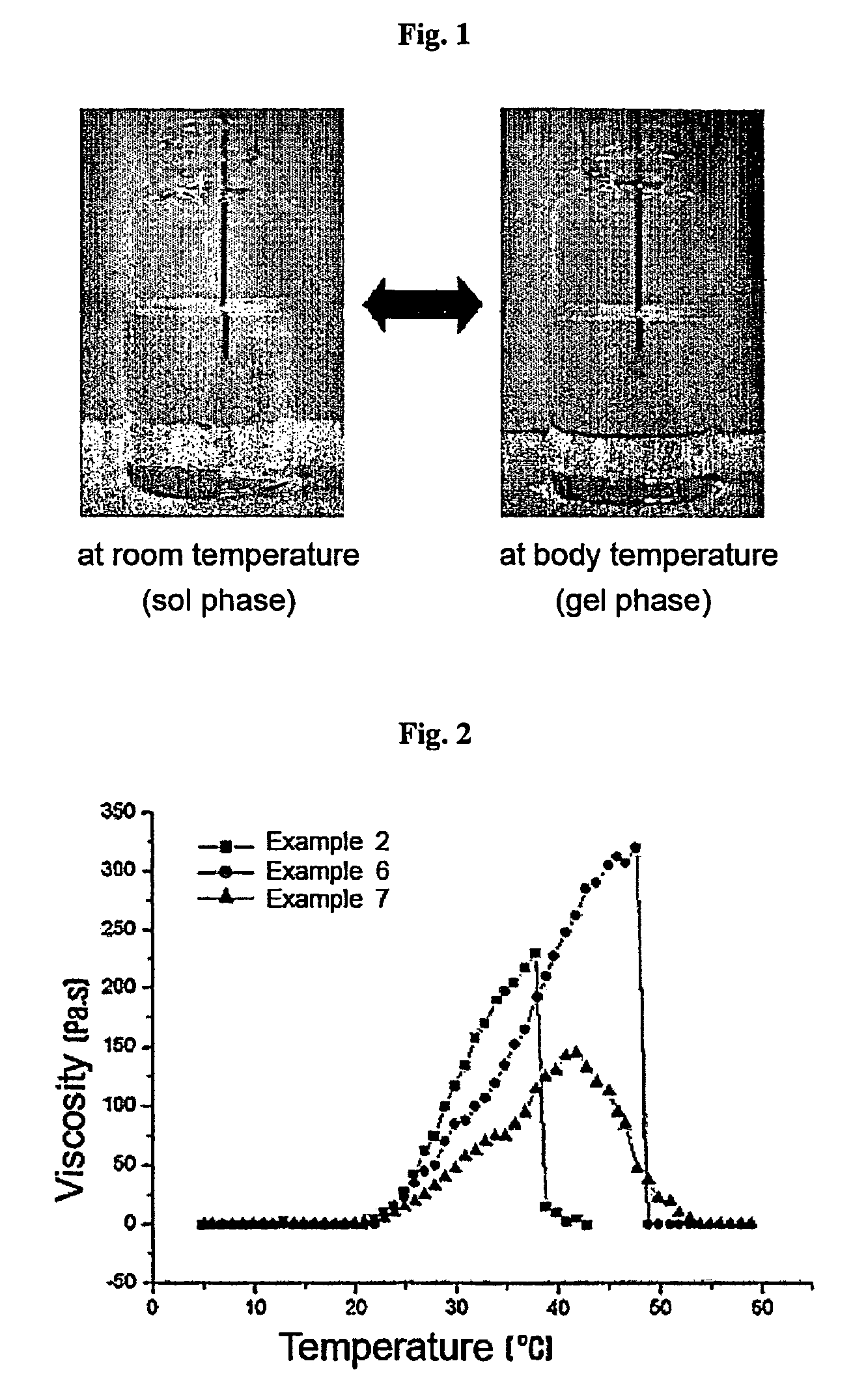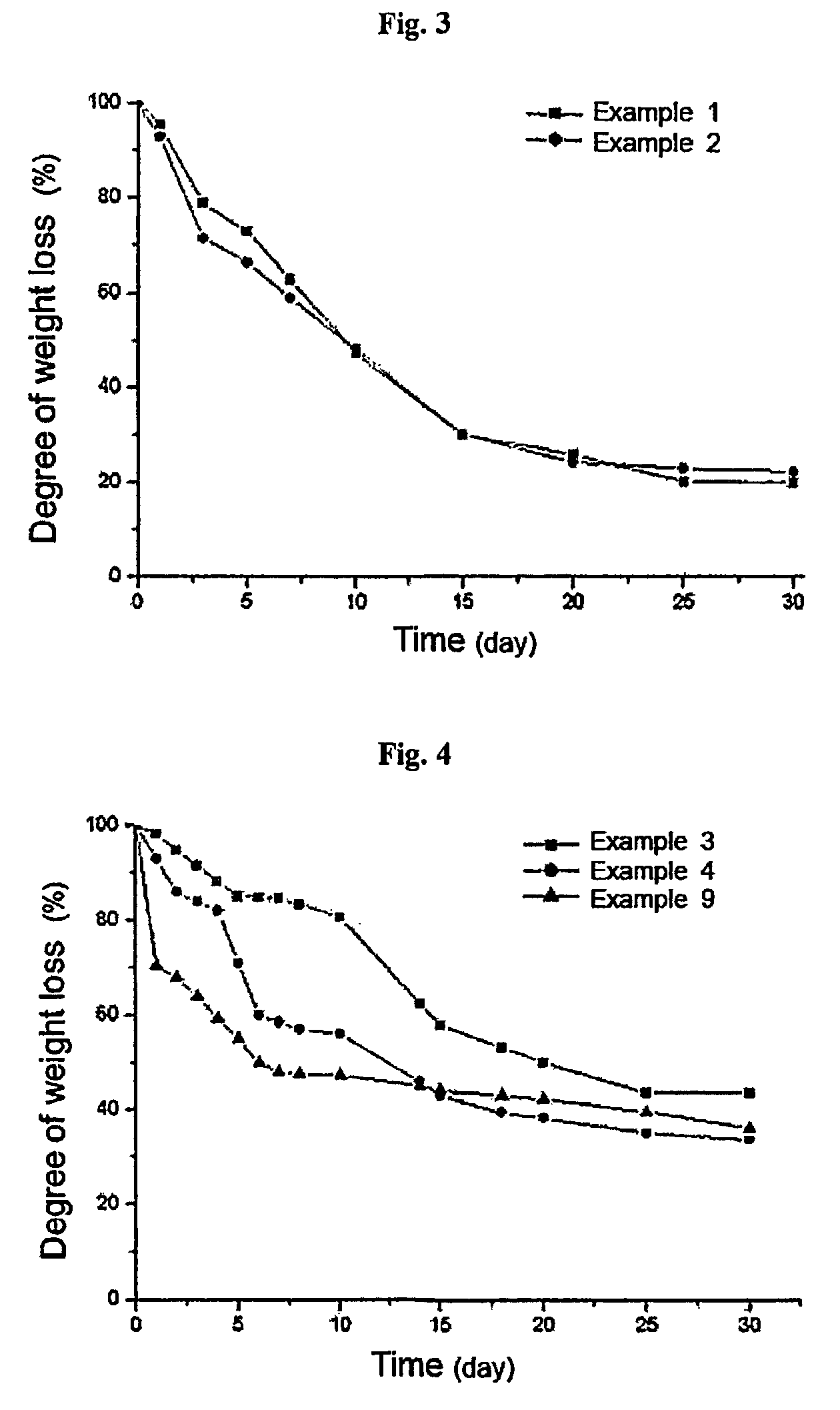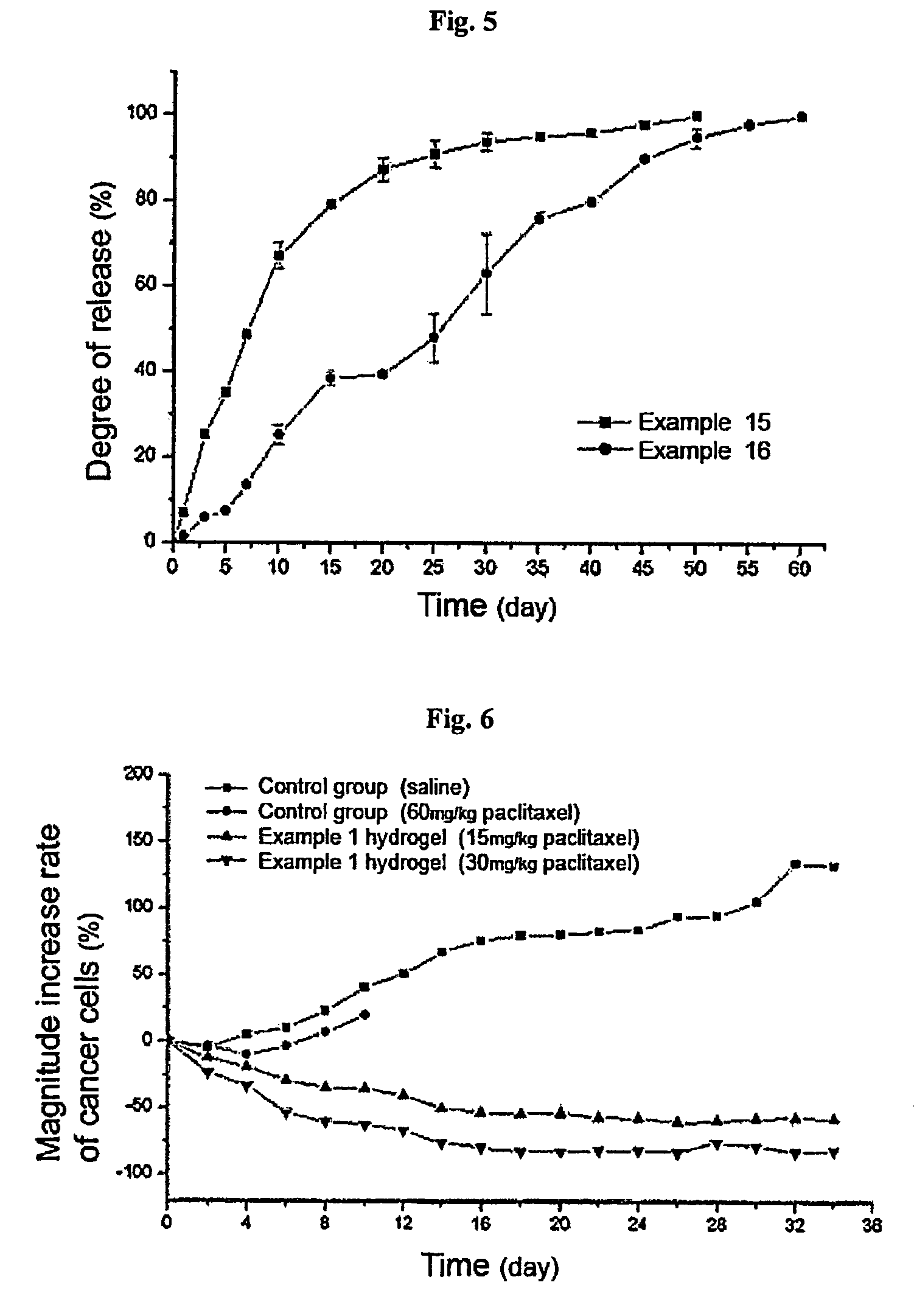Thermosensitive polyphosphazene-bioactive molecule conjugates, preparation method thereof and use thereof
a bioactive molecule and thermosensitive technology, applied in the field of polyphosphazene-organophosphazene bioactive molecule conjugate, can solve the problems of large amount of 30% or more of drugs to be released, inability to sustain the release of drugs, and functional groups
- Summary
- Abstract
- Description
- Claims
- Application Information
AI Technical Summary
Benefits of technology
Problems solved by technology
Method used
Image
Examples
example 1
The Preparation of poly[(isoleucineethylester)(aminomethoxypolyethyleneglycol 550)(glycylglycine)(glycylglycylpaclitaxel)phosphazene], [NP(IleOEt)1.25(AMPEG550)0.51(GlyGlyCOOH)0.22(GlyGlyPTX)0.02]n
[0121]Dried isoleucine ethylester chlorohydrate (4.22 g, 21.58 mmol) were dissolved in the anhydrous tetrahydrofuran (THF) 100 ml, triethylamine (6.55 g, 64.74 mmol) were added thereto. Then, the solution was added dropwisely into a dryice-acetone bath at −60° C. containing tetrahydrofuran solution (50 ml) in which poly(dichlorophosphazene)(2.00 g, 17.26 mmol) were dissolved, and then the mixture was reacted at room temperature for 48 hours.
[0122]After the reaction rate was confirmed as 31P-NMR data, dried glycylglycineallylester trifluoro aceticacid salt (1.19 g, 4.14 mmol) were melted in the anhydrous THF 50 ml. Triethylamine (1.26 g, 12.42 mmol) were added thereto, and then the mixture was reacted for 8 hours.
[0123]After again the reaction rate was confirmed as 31P-NMR data, the soluti...
example 2
The Preparation of poly[(isoleucineethylester)(aminomethoxypolyethyleneglycol 550)(glycylglycine)(glycylglycylpaclitaxel)phosphazene], [NP(IleOEt)1.25(AMPEG550)0.55(GlyGlyCOOH)0.18(GlyGlyPTX)0.2]n
[0133]The synthesis was conducted by the same method as in Example 1, except that poly(dichloro phosphazene) (2.00 g, 17.26 mmol), isoleucine ethylester (4.22 g, 21.58 mmol), glycylglycineallylester trifluoroaceticacid salt (0.99 g, 3.45 mmol), aminomethoxypolyethyleneglycol having the molecular weight of 550(10.44 g, 18.99 mmol), tetrakistriphenylphosphine palladium(0)(0.61 g), morpholine (4.85 g), paclitaxel (0.40 g), dicyclohexylcarbodiimide (0.17 g), dimethylaminopyridine (0.10 g), triethylamine (7.59 g), tetrahydrofuran (550 ml), and dichloromethane (100 ml) were used, to obtain 6.95 g of the end product [NP(IleOEt)1.25(AMPEG550)0.55(GlyGlyCOOH)0.18(GlyGlyPTX)0.02]n (yield 77%).
[0134]Empirical Formula: C30H68N8O14P
[0135]Elementary analysis data: C, 47.80; H, 9.20; N, 9.60
[0136]Theoret...
example 3
The Preparation of poly[(isoleucineethylester)(aminomethoxypolyethyleneglycol 550)(glycylglycine)(glycylglycyldoxorubicin)phosphazene], [NP(IleOEt)1.20(AMPEG550)0.60(GlyGlyCOOH)0.10(GlyGlyDOX)0.04]n
[0140]The synthesis was conducted by the same method as in Example 1, except that poly(dichloro phosphazene) (2.00 g, 17.26 mmol), isoleucine ethylester (4.22 g, 21.58 mmol), glycylglycineallylester trifluoroaceticacid salt (0.99 g, 3.45 mmol), aminomethoxypolyethyleneglycol having the molecular weight of 550 (10.44 g, 18.99 mmol), tetrakistriphenylphosphine palladium(0)(0.62 g), morpholine (4.95 g), and triethylamine (7.60 g), tetrahydrofuran (550 ml) were used, to obtain the intermediate product [NP(IleOEt)1.20(AMPEG550)0.60(GlyGlyCOOH)0.14]n (11.23 g).
[0141]The obtained [NP(IleOEt)1.20(AMPEG550)0.60(GlyGlyCOOH)0.14]n (11.23 g) was melted in the anhydrous tetrahydrofuran (100 ml) and then tributylamine (0.22 g) of 0.08 equivalent and isobutylchloroformate (0.16 g) of 0.08 equivalent we...
PUM
| Property | Measurement | Unit |
|---|---|---|
| pressure | aaaaa | aaaaa |
| temperature | aaaaa | aaaaa |
| temperature | aaaaa | aaaaa |
Abstract
Description
Claims
Application Information
 Login to View More
Login to View More - R&D
- Intellectual Property
- Life Sciences
- Materials
- Tech Scout
- Unparalleled Data Quality
- Higher Quality Content
- 60% Fewer Hallucinations
Browse by: Latest US Patents, China's latest patents, Technical Efficacy Thesaurus, Application Domain, Technology Topic, Popular Technical Reports.
© 2025 PatSnap. All rights reserved.Legal|Privacy policy|Modern Slavery Act Transparency Statement|Sitemap|About US| Contact US: help@patsnap.com



